The Intel Skylake-X Review: Core i9 7900X, i7 7820X and i7 7800X Tested
by Ian Cutress on June 19, 2017 9:01 AM ESTIntel Skylake-X Conclusion
For Skylake-X, and by virtue the Skylake-SP core we will see in upcoming Skylake-SP Xeons, Intel decided to make a few changes this time around. The biggest microarchitecture change comes in three stages: the addition of an AVX-512 unit, the adjustment in the L2/L3 cache structure, and the transition to a mesh-based topology. For the consumer and the prosumer, the biggest wins come two-fold: Intel’s 10-core processors are now set to be around $999, undercutting the previous generation by a sizable amount, but also the introduction of the new X299 chipset based motherboards that act like big PCIe switches and should offer a sizeable amount of attached functionality though additional PCIe controllers.
Microarchitecture
For the AVX-512, part of the mantra is that it should be easier for compilers to vectorize more elements of regular code bases and achieve acceleration, but for the most part it is still an enterprise feature with a focus on cryptography, compute, and the financial services industry. In silicon the unit itself is sizable, and we are told it could almost fit an Atom core inside. This is a big change to make for Intel, as it would noticeably increase the size of the full Skylake-SP core and the full die size, which has a knock-on effect. That being said, this core is targeted towards the enterprise market, which should find plenty of uses for it. It is also worth noting that not all CPUs are equal: the 6 and 8 core parts only have one FMA to play with on AVX-512, whereas the 10-core and above have two FMAs as part of Intel’s feature segmentation strategy.
The L2/L3 cache arrangement adjustments are just as nuanced, moving from a 256KB/core L2 cache to a 1MB/core L2 cache with a slightly higher latency should help with data streams being fed into the core, especially for heavy compute workloads and keeping those AVX512 units fed. The victim, in this case, is the L3 cache, being demoted to a 1.375MB/core non-inclusive victim cache, which will have limited functionality on a number of workloads, most notably compile tests. The overall cache adjustments just about balance each other out, and on average favor the new core by ~1% in our IPC tests, although the edge cases such as compilation, Handbrake (non-AVX512), and Corona can swing as much as -17%, -8% and +17% respectively.
The new mesh topology for the Skylake-SP core was perhaps more of a requirement for consistency than an option over the older ring bus system, which starts to outgrow its usefulness as more cores are added. Intel has already had success with mesh architectures with the Xeon Phi chips, so this isn’t entirely new, but essentially makes the chip a big 2D-node array for driving data around the core. As with the ring bus, core-to-core latency will vary based on the locality of the cores, and those nearest the DRAM controllers will get the best benefit for memory accesses. As Intel grows its core-count, it will be interesting to see how the mesh scales.
Parts and Performance
The three Skylake-X cores launched today are the Core i9-7900X, the Core i7-7820X, and the Core i7-7800X: 10, 8 and 6 core parts respectively using the updated Skylake-SP core, the new cache topology, and the new mesh. With some of the tests benefitting from the new features and others taking a backseat, we had a wide range of results. The most poignant of which should be when we pit this generation 10-core over last generations 10-core. The Core i9-7900X has a frequency advantage, an IPC advantage, and a significant price advantage, which should make for an easy steamrolling.
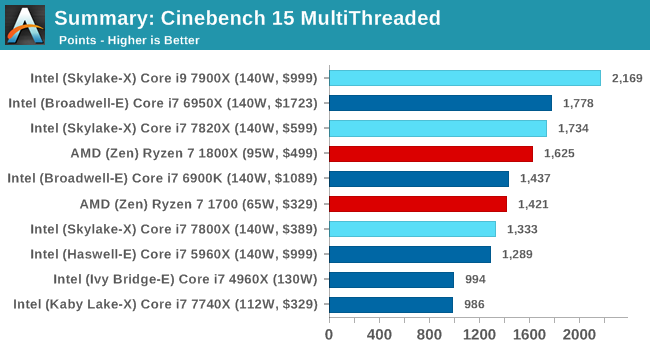
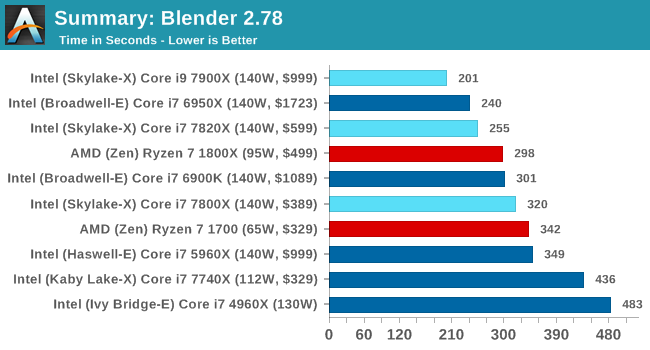
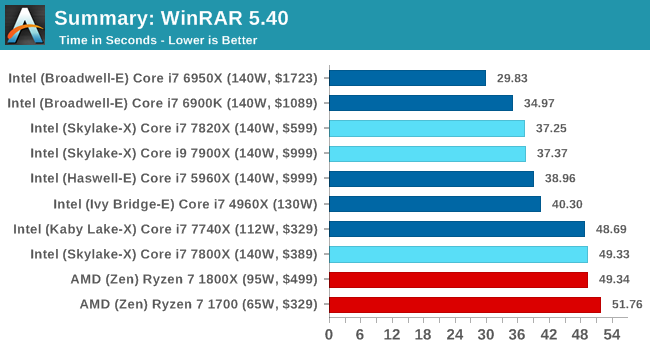
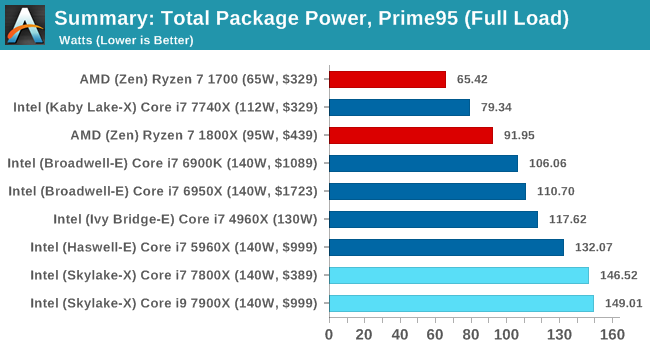
In the end, this is what we get: aside from some tests that are L3 memory sensitive such as DigiCortex, WinRAR, and some of the PCMark8 tests, the Core i9-7900X wins every CPU test. For anyone who was unsure about getting the 10-core on the last generation on a compute basis, this new one seems to be the one to get.
The gaming story is unfortunately not quite as rosy. We had last minute BIOS updates to a number of our boards because some of the gaming tests were super underperforming on the new Skylake-X parts. We are told that these early BIOSes are having power issues to do with turboing, as well as Intel’s Speed Shift technology when the GPU is active.
While these newer BIOSes have improved things, there are still some remaining performance issues to be resolved. Our GTX1080 seems to be hit the hardest out of our four GPUs, as well as Civilization 6, the second Rise of the Tomb Raider test, and Rocket League on all GPUs. As a result, we only posted a minor selection of results, most of which show good parity at 4K. The good news is that most of the issues seem to happen at 1080p, when the CPU is more at fault. The bad news is that when the CPU is pushed into a corner, the current BIOS situation is handicapping Skylake-SP in gaming.
I'm going to hold off on making a final recommendation for gaming for the moment, as right now there are clear platform problems. I have no doubt Intel and the motherboard vendors can fix them – this isn't the first time that we've seen a new platform struggle at launch (nor will it be the last). But with pre-orders opening up today, if you're a gamer you should probably wait for the platform to mature a bit more and for the remaining gaming issues to be fixed before ordering anything.
Itching for 18 Cores?
While today is the launch for Skylake-X CPUs up to 10-cores, a lot of talk will be around the 18-core Core i9-7980XE part due later this year, coming out at $1999. Double the price of the 10-core will unlikely equal double the performance, as we would expect lower frequencies to compensate. But users who need 18 lots of AVX-512 support will be rubbing their hands with glee. It will also be an interesting one to overclock, and I suspect that certain companies are already planning ahead to break some world records with it. We’ll try and get a sample in.
Should I wait for the 12-core? For ThreadRipper? Or Just Go Ryzen?
Both the 12-core Core i9-7920X and AMD’s ThreadRipper parts are set to launch this summer, with the Intel part confirmed in the August timeframe. By this time the X299 ecosystem should be settling down, while AMD will have to navigate a new X399 ecosystem, which I’m getting mixed messages about (some motherboard vendors say they are almost ready, others say they’re not even close). Both of these CPUs will be exchanging more cores for frequency, and the cost is a big factor – we don’t know for how much ThreadRipper or the X399 motherboards will retail for.
Ultimately a user can decide the following:
- To play it safe, invest in the Core i9-7900X today.
- To play it safe and get a big GPU, save $400 and invest in the Core i7-7820X today.
- To play it cheaper but competitive, invest in Ryzen 7 today.
- To invest in PCIe connectivity, wait for ThreadRipper. 60 PCIe lanes are hard to ignore.
- To invest in AVX512, wait for the next Intel CPUs.
So What’s the Takeaway Here?
From an engineering perspective, Intel is doing new things. The cache, the mesh, and AVX512 are interesting changes from several years of iterative enhancements on the prosumer side, but it will take time to see how relevant they will become. For some enterprise applications, they will make perfect sense.
From a consumer/prosumer perspective, it breaks the mold by offering some CPUs now and some CPUs later. The hardware itself won’t feel too much different, aside from having all the Intel cores and software slowly taking advantage. But Intel’s 10-core, at $999, suddenly got easier to recommend for users in that price bracket. At $599 though, the 8-core saves several hundred dollars for other upgrades if you don’t need AVX-512 or 44 PCIe lanes.


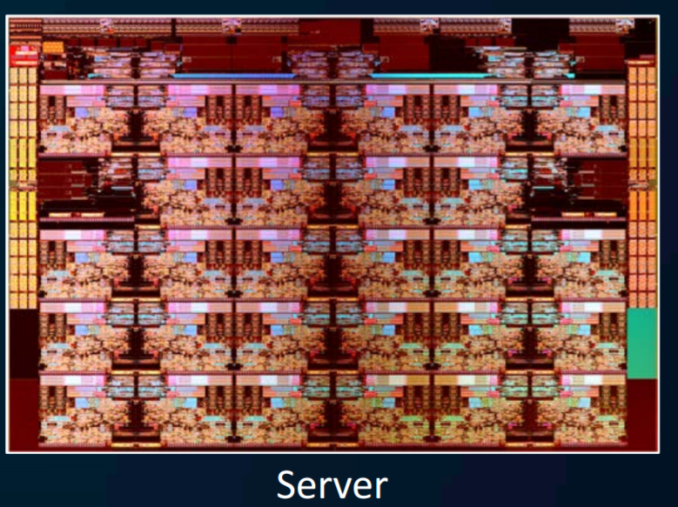
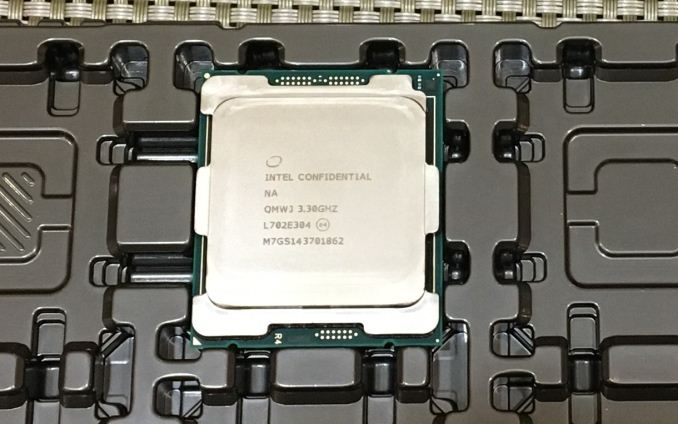








264 Comments
View All Comments
Ian Cutress - Monday, June 19, 2017 - link
Didn't get a chance to do overclocking. Testing 5 chips rather than one chip in less than a week (with BIOS issues) means I haven't slept much, and now I'm at a different event half way around the world.Ian Cutress - Monday, June 19, 2017 - link
I should add I have some 5 GHz numbers on Kaby i7. I need to find time to write but I'm fully booked today :(FreckledTrout - Monday, June 19, 2017 - link
Cool! (Pun intended)AnandTechReader2017 - Tuesday, June 20, 2017 - link
Could you also test with Speedshift on/off? Would be interesting how much of an impact it has.lefty2 - Monday, June 19, 2017 - link
One thing that is never covered by any of these reviews is the efficiency of the CPU. If you measure performance of a benchmark, then divide by the the power used in said benchmark, you will see the most efficient CPU by far is the R7 1700. All Intel Skylake-X and Kaby Lake CPUs are far less efficient (also the R7 1800X for that matter).Archie2085 - Monday, June 19, 2017 - link
@BrokenCrayonsOops .. I did not realise how odd it looked.
On a different note . tom's hardware a sister site has done a balanced review including gaming benches.. Still looks like a rushed product :)
Intel has to work on that god awful "TIM"
AnandTechReader2017 - Tuesday, June 20, 2017 - link
Wouldn't trust toms hardware since that fiasco with only Intel chips recommended for everything when the R7 1700 was clearly better a better choice.lordken - Wednesday, July 19, 2017 - link
though they do include ryzen as of next update to their CPU recommend guide. They probably re-evaluated after that shitstorm in their comments :)btw how that fits into your perspective? If they are intel biased how that they did beat i9 quite nicely.
Though I was surprised also that AT didn't talk more about power and heat issues as I did first read Toms article http://www.tomshardware.com/reviews/-intel-skylake... and after I had good lols especially after reading this fabulous line
"Ultimately, we’re looking at power consumption numbers similar to some high-end graphics cards when we start messing with Skylake-X. AMD’s FX-9590X doesn’t even come close to these results"
I came here and was surprised to not read anything here, as thermals and heat looks to be pretty tragic...
If AMD would came up with such space heater it would be all over the place...but since its intel it seems to be no issue.
Kevin G - Monday, June 19, 2017 - link
I would be hesitate to indicate that the memory controller's size is tied the same size as a CPU core for tiling purposes. Intel could easily produce a double wide, half height memory controller and place them at the ends of a column. Intel could also start putting memory controllers on two routers to remove a hop-or-two to cut down on latencies on-die. Ditto for coherecy links and IO controllers. They don't have to be rectangular and the same size of a core for optimal placement.In your mock up of the 5x6 arrangement, there is a lot of wasted space that could be negated if Intel were to re-arrange the dimensions of the IO and memory controllers a bit. Your estimate of a 677 mm^2 is spot on with what you've gone but there is incredible pressure to reduce such huge dies to make them easier to manufacturer. There is simplicity in keeping IO and memory controllers the same size as a core for rapid construction of the entire die but I think the trade off would favor smaller die size here.
Communism - Monday, June 19, 2017 - link
If you are going to post "power consumption" and "power efficiency" graphs/analysis, you need to post the performance from the "power consumption" test itself, or else it's pretty pointless when comparing vastly different CPUs.You mentioned you tested power consumption with prime95.
I'd wager the intel has a hilariously high performance per watt in prime95 as it would likely be using avx2 instructions (and the massive memory bandwidth of the cache as well as the massive memory bandwidth of the main memory/IMC combination if you are using larger dataset option).
I wonder how many hundreds of pages of AMD shill posts that this post will be buried under within hours :P
Oh well, any actual readers should wait for a DigitalFoundry review whenever that happens to come out if you want useful game testing results anyways.